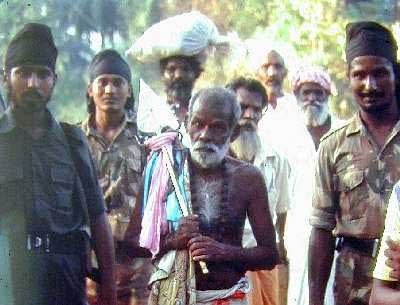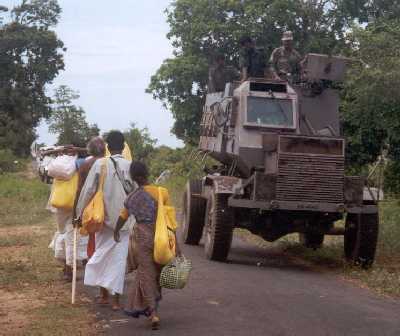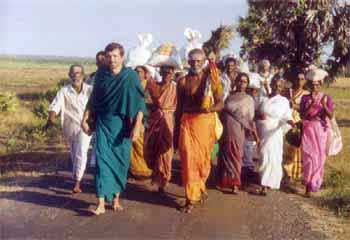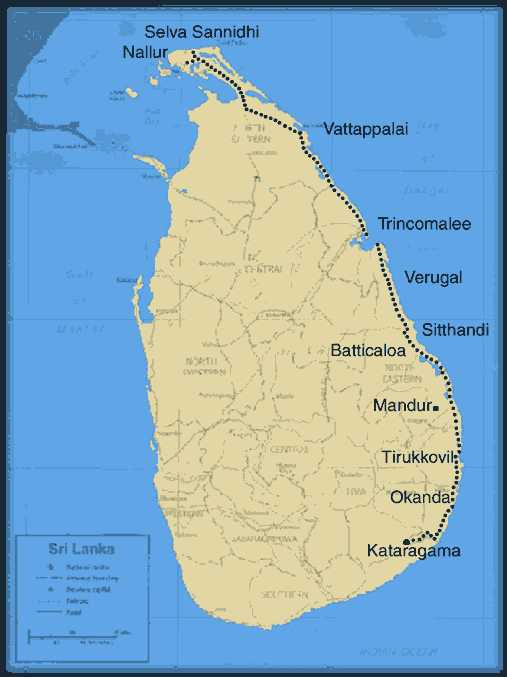|
| |||||||||||
 Love, War and Mystery: A Sri Lanka Diary
June 23, 1988, Trincomalee Bay. Those days there was scarcely a clue of the violent trials that lay ahead for this once-quiet tropical paradise famous for its Ceylon tea and ancient culture. An amalgam of Hindus, Muslims, Christians, and mostly Buddhists, Sri Lanka was considered a model democratic state by Asian standards. But the seeds of discord had been planted long ago. Four and a half centuries of European imperialist occupation had enforced peace upon the island's ethnic communities at the same time that it exploited their differences. With independence, majority Sinhalese - mostly Buddhists - came to resent the relative economic success of the Tamil middle-class, whose dry homeland in the north fostered a work ethic and the drive for higher education that eventually netted them most of the prestigious jobs in a frail economy. Sensing a popular partisan issue, Sinhala politicians later used their natural majority in Parliament to pass discriminatory legislation designed more to please the electorate than to achieve social justice. Ethnic tensions smoldered over decades, occasionally erupting into arson and rioting by Sinhala ultra-nationalists against a defenseless minority of Tamils Hindus who, to no small extent, resembled the Jews of other societies. By the mid-1970's, a few Tamils were openly calling for a separate state, call Tamil Eelam, to be carved out of the Northern and Eastern Provinces where Tamil-speaking people were a majority. Those who at first only advocated violence began to employ it freely against Tamil moderates, government workers, and each other. The spiral of violence culminated in July 1983, with a week-long Krystalnacht by rioting Sinhalese mobs that left hundreds of Tamils dead and thousands homeless. In the years of bloodshed that followed, armed insurgents and government security forces alike committed atrocities that few could have imagined only a decade before. Tamil refugees flooded India and Europe. Sri Lanka's economy floundered, and her neighbors grew concerned about the threat to the stability of the whole region. Would powerful nations seek to exploit the situation to gain naval access to Trincomalee's superb harbor? With pressure from India, a three-way settlement appeared to be reached in 1987 with the signing of the Indo-Sri Lanka Peace Accord between the governments of India, Sri Lanka, and the league of rival factions of Tamil insurgents. But not long after India began sending over fifty thousand peacekeeping troops to guarantee the accord, the major separatist group resumed fighting, this time against Sri Lankan and Indian forces alike. Squinting under the tropical sunlight after a sleepless all-night bus ride from Colombo, I am struck by the changes to Trincomalee. Half of the town's buildings have been destroyed in communal riots since 1983. Indian army troops are everywhere; many are Sikhs, easily recognizable by their army-issue turbans and proud martial bearing. Tourists are forbidden here, but an official pass allows me to join the ragged band of pilgrims whose stubborn insistence in reviving the tradition of walking around the island, war or no war, has attracted wide attention. A launch takes me across the huge bay with its docks of naval craft. Dressed in plain sarong as pilgrim's dress, I land upon the beach at Mutur under a scorching sun and dash barefoot across the burning sand to a machinegun position where a pair of drowsy Sikh jawans (soldiers) stare with incomprehension. Obviously, they were not expecting this. In rusty Hindi, I ask which way the foot pilgrims have gone. The corporal wants to know who I am and what exactly I am doing here. Alert to his duty, he promptly takes me into custody, and we march to battalion headquarters. It is a tarred road, and the tropical sun is already high. It must be an extraordinary sight for these villagers to see a barefoot white man in a sarong hopping on the hot pavement, escorted by an armed and foot-clad Indian soldier. Later that morning at battalion headquarters. Indian tea and biscuits with Colonel Sethi, a product of Sandhurst military college. Of course, I am free to go. They will see to it that I link up with the pilgrims who are just ahead. But there are so few of them! Where are the rest? The army had been expecting hundreds, or even thousands, to be marching this way. In India there would be thousands of pilgrims. But this is Sri Lanka, not India. An Indian army jeep delivers me to where the pilgrims are resting. There are barely twenty of them, mostly old men and women. One of them, Vel Swami, has done the annual walk fifty times. They have had to make long detours around mine-ridded parts of the country to get here. They are visibly weary, but are still singing and worshipping at little shrines along the way. I recognize a few of them from sixteen years ago. Without ceremony or explanation, I simply join the party.
It is late afternoon before we try to walk on the hot road again. A company of Indian jawans accompanies us. They carry a mortar and automatic weapons against eventual ambush by insurgents. From Mutur onwards, I notice that every building in the district has been destroyed. Huge craters in the road mark the spots where big military trucks were blown up by land mines. The Indian army had learned the hard way to start moving troops in jeeps and light trucks to cut their losses. Helicopter gunships patrol over-head. Indian soldiers and Sri Lankan pilgrims mingle as we spread out, some pilgrims walking slower than others. Some soldiers, already burdened with weapons and equipment, offer to carry old pilgrims' bundles. Do they even know that these pilgrims are walking for Skanda, the patron god of soldiers? Most speak only Hindi or another Indian language, while the pilgrims are Tamil-speakers. I have become the ad-hoc interpreter for two 'armies' in one. Dusk. We are strongly encouraged to make our camp within the defense perimeter of an army base. But the pilgrims would rather sleep at a nearby shrine to the elephant-headed god, Ganapati, Skanda's older brother. Both gods are notorious pranksters, but their shrines are felt to be preferable to whatever comforts or security the Indian Army can offer. Finally, we prevail. The platoon sergeant can only shrug his shoulders and promise to report back tomorrow. The occasional distant explosions at night only serve to accentuate the eerie calm of a moonless tropical sky. If the seeds of death and destruction appeared in times of nominal peace, then it is equally true that the seeds of life and cultural survival may be found in the midst of war. Here, as in any war, something of value must survive, or else both sides lose in the end. Sri Lanka's ancient culture has witnessed holocausts before. Her people have learned to take them in stride, with hope for the future, even when the future looks grim. Nobody can predict the outcome of this struggle as it grinds on with a terrible human toll. But the job of picking up the pieces, of making a new beginning has already begun. This article by Patrick Harrigan appeared in India Currents magazine (San Francisco) Vol. 3 No. 2 of May 1989 Patrick Harrigan (M.A., University of Michigan) has been acting editor of the Kataragama Research Publications Project since 1989. See also these reports: Pada Yatra 1997 | Pada Yatra 1999 | Pada Yatra 2000 | Pada Yatra 2001 | Pada Yatra 2002 Kataragama Devotees Trust
|



